

In this Part ( Part XXV-A and Part XXV-B ) :
While in this theoretical intermezzo all our discussions about groundplans (order-, family-, or genus-groundplan) are meant to be general, we consider the Order Diptera (and thus dipterous order-, family-, and genus-groundplans) to represent a "background framework of reference", that is to say, in designing general theories of evolution we think of what we see in the (evolution of the) Order Diptera, an Order so familiar to us and inspiring us, but at the same time we fully realize that the evolution of groups, groundplans, and adaptations as we see it in the Order Diptera does certainly not exhaust all types of (biological) events that have actually taken place at certain times and in certain groups during the course of organic evolution. And our general theory, that is our general noëtic theory of evolution, must be such as to able to accommodate to all these types of evolutionary events, that is to say, they must have their natural places in our theory.
The evolution of organic groundplans in terms of their noëtic stability fields in the Implicate Order. (Later to be applied to the evolution of dipterous groundplans)
An organic groundplan is a structure that is commonly possessed by a group of organisms. The nature of such a groundplan is first of all morphological. But because it also comprises the chemical nature of the organisms of such a group (of organisms) it is also (chemico-)physiologically defined. Generally we simply speak of "structure" when referring to a groundplan.
In insects (= six-legged arthropods) we have, first of all the groundplan "insect". It is a structure that is commonly possessed by all insects. This groundplan diversifies, giving rise to the various groundplans of the different insect Orders (such as Orthoptera [crickets, grasshoppers, and locusts], Lepidoptera [moths and butterflies], Hymenoptera [saw-flies, wasps, bees, and ants], Coleoptera [beetles], Diptera [two-winged flies], etc.). The groundplan of a given insect Order in turn diversifies, giving rise to family-groundplans or groundplans of groups of related families. It is not clear whether one can speak of groundplans of taxa below the family level because we define an independent organic structure, that is instantiated by individuals, to be a groundplan if it has no specific ecological significance. Genera and species do probably all have ecological significance, that is, their formation is ecologically determined.
As defined above, organic groundplans exist in the Explicate Order, but there they are not as such present but are always instantiated by organic individuals existing in space and time. Further, as existing in the Explicate Order a groundplan is always contained in a 'shell' of adaptive structures. These adaptive structures allow such a groundplan to actually live -- as instantiated by organic individuals -- in a specific ecological zone or (more narrowly) ecological niche. The groundplan itself lacks specific ecological meaning, it only complies with the general requirements of life. In what follows we will concentrate on the groundplans of dipterous families (such as, say, the Empididae), superfamilies (such as, say, the Fungivoridea), and groups of families (such as, say, the Acalyptrate flies). In general discussions we simply refer to them as "family-groundplans".
These groundplans are also considered to exist in the Implicate Order. There they exclusively exist as noëtic patterns and are therefore not instantiated by individuals. And they are separated from each other not by spatial but by noëtic distances (defining their qualitative differences).
The specific qualitative nature of a given groundplan, as it exists in the Implicate Order, defines, all by itself, a series of possible conditions of existence in the Explicate Order, that is, it defines possible ecological niches. As we have said, a groundplan has no ecological meaning. Therefore it does not define a specific ecological niche in which its individual instantiations can live (in the Explicate Order). Its ecological significance is only general, therefore it defines a whole range of ecological niches in which its individual instantiations might be able to live. Each ecological niche of such a range, as existing in the Explicate Order, has a definite qualitative nature and as such also noëtically exists in the Implicate Order, together with the natures of the other ecological niches of that range, alongside the (noëtically existing) groundplan that defines that ecological range.
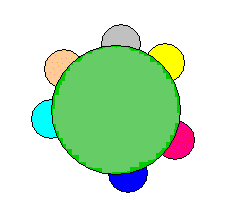
Figure 1 : Diagram of groundplan (large green disc) and the ecological niches (small semi-discs) defined by it. As such, groundplan and ecological niches exist as noëtic patterns in the Implicate Order. The ecological niches are the possible conditions of existence in the Explicate Order. In the Implicate Order they are, like the groundplan, present in the form of noëtic patterns.
The groundplan, insofar as it exists as a noëtic entity in the Implicate Order is, as any noëtic entity, a potential noëtic reactant. And any possible ecological niche as defined by the nature of the groundplan and insofar as it exists as a noëtic entity in the Implicate Order, can be a noëtic reactant that is reactively compatible with the groundplan. So we can expect a noëtic reaction to occur between these two noëtic reactants (groundplan and ecological niche). The next Figure diagrammatically depicts the noëtic product of this reaction :
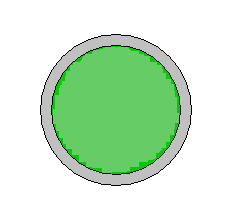
Figure 2 : Diagram of the noëtic product of the noëtic reaction between (1) the groundplan and (2) one of the ecological niches defined by it, both ((1) and (2)) as noëtic reactants. We now have the groundplan with adaptive structures added to it as it is present in the Implicate Order in the form of a complex noëtic entity or pattern. And only as such, that is, with the added adaptive structures, the groundplan can be projected into the Explicate Order. We can also say that the described noëtic reaction as it takes place in the Implicate Order will be seen in the Explicate Order as organisms evolutionarily acquiring the adaptations to a certain ecological niche.
A groundplan, as noëtic reactant, can, as has been said, react with one of the possible ecological niches (= conditions of existence in the Explicate order), this niche also present as a noëtic reactant. We then obtain one noëtic reaction product. But of course the groundplan can react with all its possible ecological niches successively, resulting in more than one noëtic reaction products. So if we have a groundplan A , defining a number of possible conditions of existence a, b, c, d, and e in the Explicate Order (that is, possible ecological niches), the groundplan can, as a noëtic reactant, react successively with many or all of these possible conditions as they are present as noëtic reactants. As a result we then can have the following noëtic reaction products : A(a), A(b), A(c), A(d), and A(e). And these reaction products can be projected more or less simultaneously or successively into the Explicate Order. And it is in the Explicate Order then that we see a particular family of Diptera evolutionarily fanning itself out over the ecological landscape, that is, its various species successively occupying one ecological niche after the other. And although some of these niches might be more or less similar they differ nonetheless, and each species of that family -- representing one single groundplan -- has colonized a different niche.
In addition to the evolutionary acquisition of adaptive structures by a single given groundplan, as we see it happening in the Explicate Order, we also see there a historical succession of different family groundplans, such as the succession : Protorhyphoid ==> Rhagionoid ==> Empidoid ==> Clythioid ==> Muscoid groundplans in the evolutionary history of Diptera. And we know that the transition from one groundplan to another has no specific ecological meaning or significance, that is the transition is not caused by ecological factors. The explanation of the succession of different family groundplans cannot therefore go along ecological lines. We instead will use for it the mineral stability diagrams which are held to represent a physical analogue of what happens with the groundplans in the Implicate Order and what is seen as a result (projection) in the Explicate Order.
The different groundplans as they are present in the Implicate Order are noëtically derived from each other. This derivation can be compared with the transformation of one mineral phase (of a given substance) into another, such as the transformation of Ice-I into Ice-II in the system H2O (see Figure 16 in previous document (top image) ), accomplished by increase of pressure, or of Andalusite into Sillimanite (see Figure 17 in previous document (bottom image) ), also accomplished by increasing the pressure. In both cases the one mineral phase is physically derived from the other. In the mineral examples one given particular phase is stable when ambient conditions of pressures and temperatures are within a certain range, specified by its stability field. Upon changing these conditions, nothing happens as long as they remain within the range specified by the stability field. But when they have changed such that they are now within the range specified by the stability field of one of the other phases of the system, the original mineral becomes unstable, and when sufficient activation energy is present (in cases where there exists an energy barrier between phases) it will transform into the other phase (and so into another mineral).
When we have to do with a locally existing volume V of a given chemical substance, and when, within the confines of this volume, there exists a temperature and pressure gradient (that is, the temperature gradually increases along a certain direction in this volume, and pressure also gradually increases along a direction, say, perpendicular to that of temperature), then the result will be a patchwork of separated sub-volumes of different phases of the system, that is, each sub-volume consists of one phase, so each phase is then physically present precisely, and within the overall volume V exclusively, in that particular region (subvolume) of the volume V where the temperatures and pressures are within the T-P stability field of that phase.
We suppose that something like this happens with organic family-groundplans insofar as they exist in the form of noëtic entities (noëtic phases) in the Implicate Order. Here too such a groundplan is stable or unstable depending on ambient conditions. But in this case these conditions are, of course, not pressure and temperature or any other physical variable, but are certain hypothetical noëtic variables. These variables have to do with qualitative compatibility of different noëtic contents (groundplans and all other existing noëtic patterns) lying in or between certain ranges of these variables, that is, they define stability fields within which certain groundplans can noëtically exist stably and between which, that is, right on common boundaries, two or more groundplans can noëtically coexist (being in noëtic equilibrium with each other). In many cases a given groundplan can even exist a little outside its proper stability field : Although it is not noëtically stable there, it can exist noëtically metastably. The number of such noëtic variables is certainly more than two, even more than three, so that the noëtic stability fields of groundplans are in fact multi-dimensional volumes. Of course, here, that is in the Implicate Order, we only speak of "dimensions", "fields", and "volumes" in a metaphorical way, because in the Implicate Order -- the immaterial, noëtic Order -- there is no space, that is, there are no dimensional entities. Also, there is no extension along the Time dimension. Space and time are only present as mathematical parameters embedded within mathematical -- noëtical -- structures.
In order to make all this intuitively clear we assign to the Implicate Order only t w o overall conditional variables (like we have it in systems of mineral phases -- there temperature and pressure) which we call respectively X and Y, and we present them metaphorically as spatial dimensions (like in mineral stability diagrams). So we obtain an overall noëtic X / Y space in which the noëtic stability fields of the various groundplans can be defined :
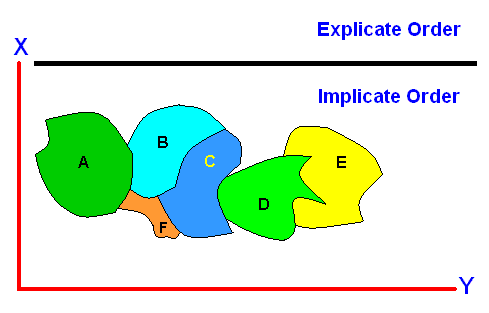
Figure 3 : Noëtic X / Y space and stability fields of some organic groundplans, A, B, C, D, E, and F, in the Implicate Order.
Of course there are many more such noëtic stability fields in X / Y space, but for clarity we depict only a few of them.
From its noëtic stability field a groundplan can be projected into the Explicate Order, but not before it has noëtically reacted with the noëtic content of one of its potential ecological niches. An then the reaction product will be projected into the Explicate Order. Indeed, the (noëtic content of the) groundplan reacts with the noëtic content of every ecological niche that is defined by it, and all resulting different reaction products can then be projected into the Explicate Order (in fact only those will be projected that contain adaptations to existing -- in the Explicate Order -- ecological niches). The next Figure illustrates this diagrammatically for one groundplan.
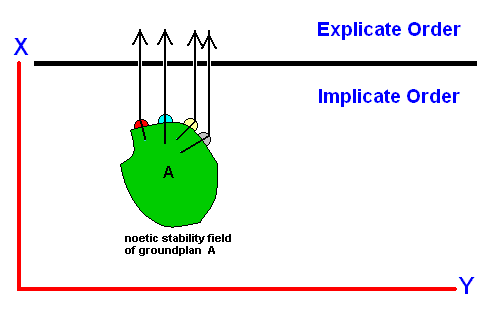
Figure 4 : From its stability field in the noëtic X / Y space of the Implicate Order the (noëtic content of the) groundplan A repeatedly projects into the Explicate Order. But it does so only after it has reacted with the noëtic content (small semi-disc) of one of its potential ecological niches, that is, the groundplan always projects into the Explicate Order in the form of a reaction product. This reaction product consists of the (noëtic content of the) groundplan together with (the noëtic content of) a certain adaptational structure added to it. In this way we see in the Explicate Order the appearance along a bunch of parallel lines of more or less similar organisms all possessing this particular groundplan A and in each line provided with a different adaptational structure. So in the Explicate Order each such line ends up in its proper ecological niche (that is, in one or more individual instances of this proper niche). See next Figure.
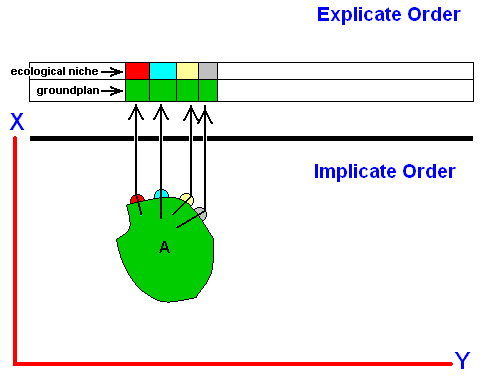
Figure 5 : Projection of the reaction-products of the reaction between the noëtic content of groundplan A with the noëtic contents of its potential ecological niches, from the Implicate Order into the existing proper ecological niches (red, blue, yellow, brown) in the Explicate Order. Each such an ecological niche will thus be colonized by, generally, many instantiations of this groundplan, that is to say, by individual organisms possessing this groundplan and the necessary adaptive structure.
Like a groundplan, a given (specific) ecological niche is present in the Implicate Order as just a (single) definite noëtic pattern, while in the Explicate Order it is present in the form of many instantiations of it, that is to say, there, generally, are more than one locations that represent this ecological niche. And, also like a groundplan, its instantiations can be distributed along the Time dimension too.
In addition to the noëtic content of groundplan A, the noëtic content of another groundplan, say that of B, can be projected into the Explicate Order, where we see it occupying several ecological niches :
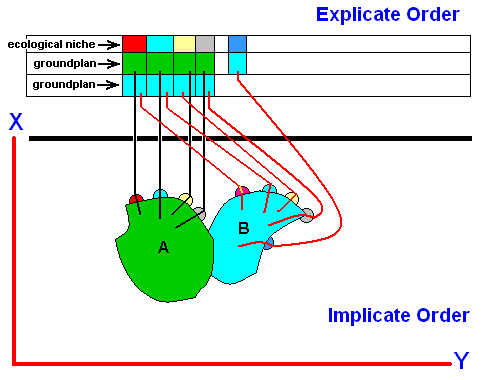
Figure 6 : Projection of the reaction-products of the reaction between the noëtic contents of the groundplans A and B with the noëtic contents of their potential ecological niches, from the Implicate Order into the existing proper ecological niches (red, blue, yellow, brown, dark blue) in the Explicate Order. Four potential ecological niches of groundplan B happen to be very similar to four niches of groundplan A ( They cannot, however, be identical, because by definition two different species of organism cannot occupy exactly the same ecological niche. Their habitat may be the same, but the exact nutritive substrate is different). In addition to the four ecological niches mentioned, groundplan B has yet another potential ecological niche. So in the Explicate Order groundplan B occupies five different ecological niches, four of which are similar to those that are occupied by groundplan A.
As it was in the case of groundplan A, the projection of groundplan B proceeds along parallel lines. Of course it is possible that there is only one such line. But in that case only one ecological niche will be occupied by the groundplan.
The noëtic content of groundplan B is supposed to have originated (= noëtically derived) from that of groundplan A. Groundplans A and B are supposed to represent two different polymorphs of a same higher groundplan. In the field marked "B" (see Figures) the noëtic conditions are such that (the noëtic content of) groundplan B is noëtically stable, while (the noëtic content of) groundplan A is not stable or only metastable. The noëtic content of groundplan A is stable in the field marked "A".
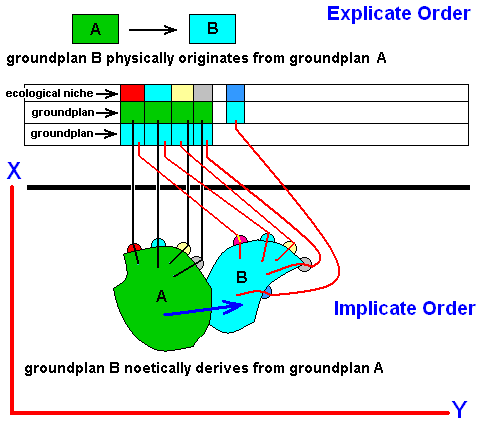
Figure 7 : While originally the noëtic content of groundplan B is, in the Implicate Order, a derivative of that of groundplan A, in the Explicate Order this is experienced (by us) as the physico-biological (i.e. evolutionary) transformation of the groundplan A into groundplan B.
Here we are considering groundplans that are noëtically more or less similar. They noëtically derive from each other. However, because in the Explicate Order we see such groundplans, upon projection, historically appear one after another and irreversibly so, we must assume that the corresponding noëtic derivations in the Implicate Order proceed monotropically, that is, irreversibly, like it is -- in mineral transformations -- the case in the transformation of Aragonite into Calcite as a result of increasing temperature. Calcite can never be transformed back into Aragonite anymore (by decreasing the temperature). Conversely, we can now say that because the noëtic derivation of such groundplans is monotropic we experience this as an irreversible (evolutionary) succession of morphologically related groundplans in the Explicate Order.
In the above Figures we have let groundplan B define five possible ecological niches of which four are very similar to the four possible ecological niches defined by groundplan A. That is just an example. Groundplan B could equally well supposed to be such that it defines, say, three possible ecological niches, none of which is similar to one of the possible niches of groundplan A :
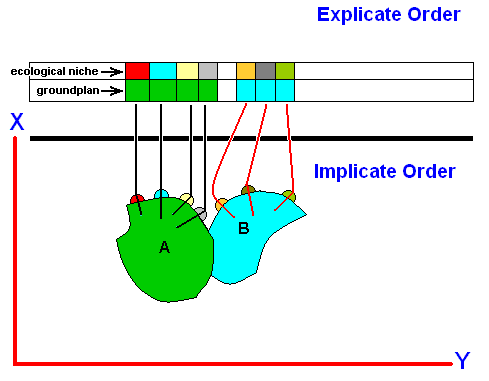
In some cases a groundplan can also exist a little outside its stability field. It then, however, exists only metastably ( In the Explicate Order we experience this by observing that the group (family, superfamily, etc.) possessing this groundplan is in a state of evolutionary decline). See next Figure.
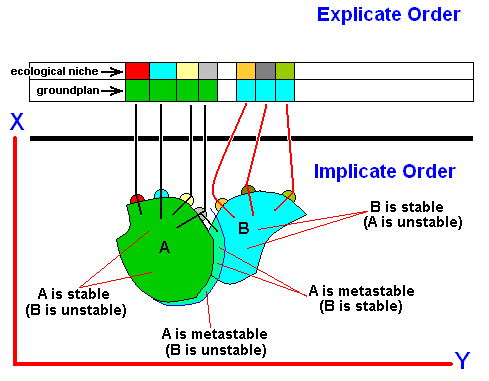
Figure 8 : Noëtic stability, metastability, and instability of a groundplan in the Implicate Order. In addition to the proper noëtic stability field of groundplan A, there can exist a small zone (light green), lying just beyond the border of the stability field, a zone that is, in which the conditions are such that groundplan A can, although not stably, nevertheless exist metastably.
Also groundplan B can be supposed to be able to exist metastably outside its proper stability field :
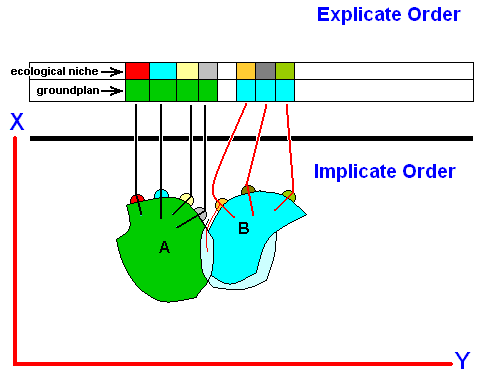
Figure 9 : In addition to the proper noëtic stability field of groundplan B, there can exist a small zone (very light blue), lying just beyond the border of the stability field, a zone that is, in which the conditions are such that groundplan B can, although not stably, nevertheless exist metastably.
It can also be the case that the stability fields of both groundplans (having their proper stability fields adjacent to each other) have their own extension of conditions of metastability. In such a case there exist metastability zones at both sides of the boundary between two adjacent stability fields.
The next Figure diagrammatically depicts the successive and irreversible derivation of groundplans in the Implicate Order, and the corresponding successive and irreversible evolutionary appearance of these groundplans in the Explicate Order.
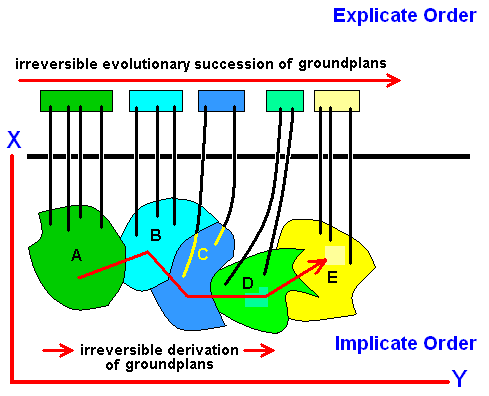
Figure 10 : Successive projections of the noëtic contents of the groundplans A, B, C, D, and E, from the Implicate into the Explicate Order. Each projection of a groundplan consists of a bundle of lines, that is, a bundle of repeated projections, which in turn end up in different ecologies.
The groundplans here considered, are supposed to be such that their noëtic derivation can proceed in one direction only (like we see it -- analogously -- in the monotropic Aragonite ==> Calcite reaction), resulting in an irreversible evolutionary succession of groundplans in the Explicate Order.
The next series of Figures diagrammatically depicts the successive stages of the evolution of different but related groundplans, monitored from, say, the Permian, through the Triassic, Jurassic, Cretaceous, Tertiary, up to the Recent epoch.
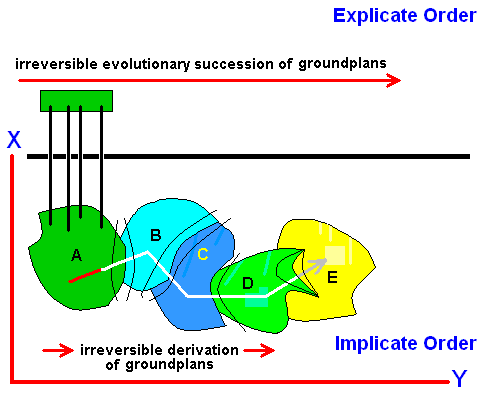
Figure 11a : Lower Permian stage. The red line segment indicates where in the succession of noëtic derivations we are.
Metastability extensions of the true stability fields are, where present, demarcated by thin curved lines.
The noëtic content of groundplan A is stable, and is therefore projected into the Explicate Order. There we see a family of organisms existing (say a dipterous family or family group) of which all individuals carry groundplan A, but are distributed over several different ecological niches.
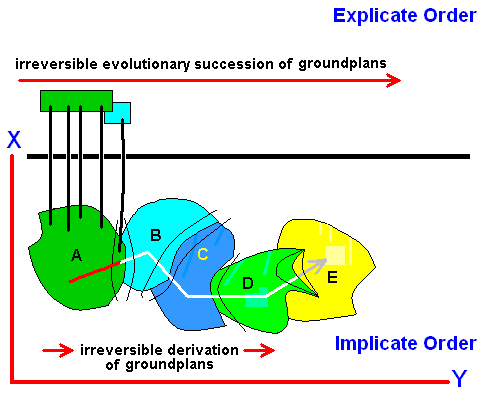
Figure 11b : Upper Permian stage. The red line segment indicates where in the succession of noëtic derivations we are.
We are now in a domein where the noëtic conditions are such that groundplan A is still stable, and is therefore still projected (into the Explicate Order). Further, the next groundplan, groundplan B, is metastable in these conditions. In the Explicate Order it appears for the first time. It has not (yet) radiated into a number of different ecological niches.
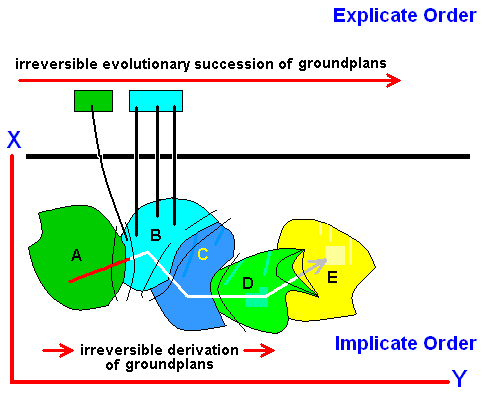
Figure 11c : Lower Triassic stage. The red line segment indicates where in the succession of noëtic derivations we are.
We have now left the proper stability field of groundplan A and have entered the stability field of groundplan B. Groundplan A is now (noëtically) existing only metastably and is therefore represented in the Explicate Order by a declining group of organisms occupying only a few ecological niches. Groundplan B is (noëtically) stable and is projected into the Explicate Order occupying there several ecological niches.
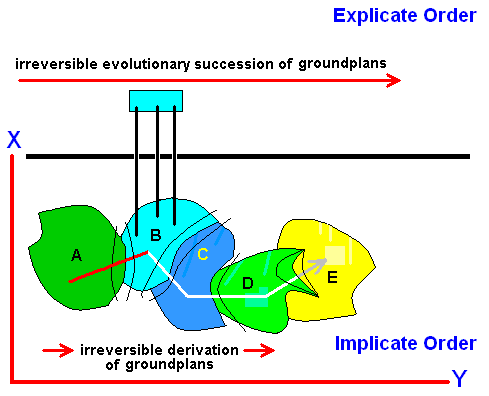
Figure 11d : Middle Triassic stage. The red line segment indicates where in the succession of noëtic derivations we are.
We are right in the stability field of groundplan B, having left the metastability extension of the (proper) stability field of groundplan A. So here groundplan A cannot (noëtically) exist and is therefore not projected anymore into the Explicate Order. There we see that all organismic species carrying the old groundplan A have become extinct. Groundplan B flourishes in the Explicate Order. It still is distributed over a number of different ecological niches.
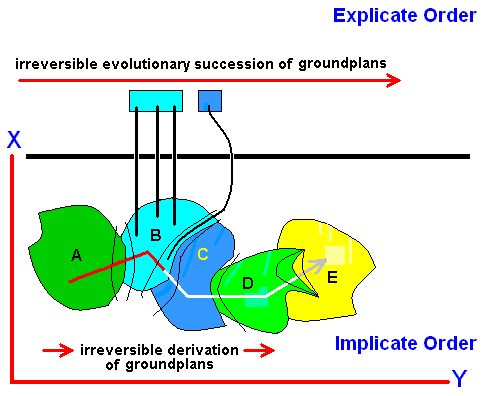
Figure 11e : Upper Triassic stage. The red line segment indicates where in the succession of noëtic derivations we are.
We are now in a domein where the noëtic conditions are such that groundplan B is still stable, and is therefore still projected (into the Explicate Order). Further, the next groundplan, groundplan C, is metastable in these conditions. In the Explicate Order it appears for the first time. It has not (yet) radiated into a number of different ecological niches.
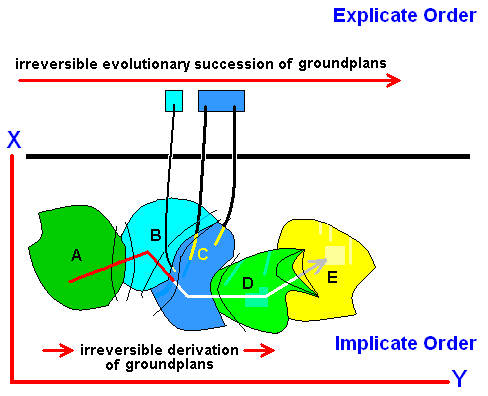
Figure 11f : Jurassic stage. The red line segment indicates where in the succession of noëtic derivations we are.
We have now left the proper stability field of groundplan B and have entered the stability field of groundplan C. Groundplan B is now (noëtically) existing only metastably and is therefore represented in the Explicate Order by a declining group of organisms occupying only a few ecological niches. Groundplan C is (noëtically) stable and is projected into the Explicate Order occupying there several ecological niches.
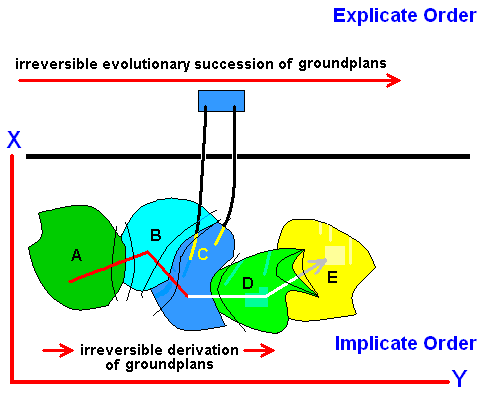
Figure 11g : Lower Cretaceous stage. The red line segment indicates where in the succession of noëtic derivations we are.
The (noëtic) conditions are now such that groundplan B cannot noëtically exist, even not metastably so. Groundplan C is (still) noëtically stable and it is still projected into the Explicate Order where it occupies several different ecological niches.
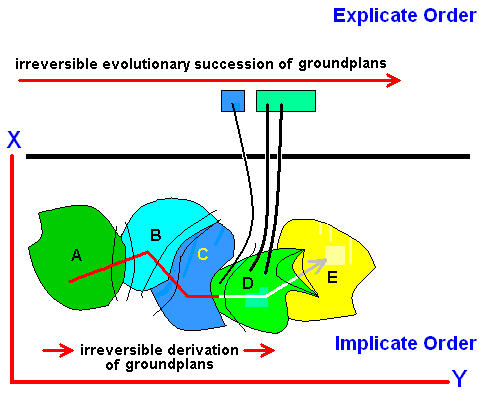
Figure 11h : Upper Cretaceous stage. The red line segment indicates where in the succession of noëtic derivations we are.
Although we have left the proper stability field of groundplan C, and have entered that of groundplan D, groundplan C can still noëtically exist, albeit only metastably. And because groundplan D is stable, it is projected into the Explicate Order where it occupies several different ecological niches.
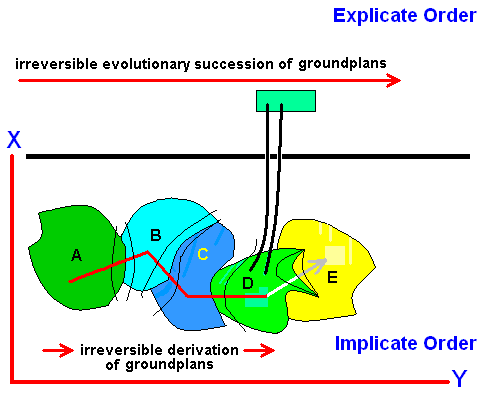
Figure 11i : Lower Tertiary stage. The red line segment indicates where in the succession of noëtic derivations we are.
Groundplan C is unstable. It cannot noëtically exist under these conditions, even not metastably so. Groundplan D is (still) stable and still projects into the Explicate Order, occupying several different ecological niches there.
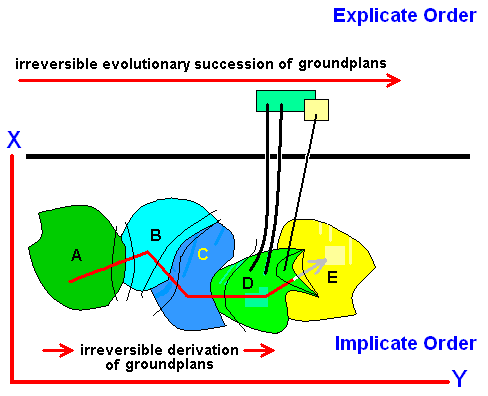
Figure 11j : Upper Tertiary stage. The red line segment indicates where in the succession of noëtic derivations we are.
Groundplan D is (still) stable and still projects into the Explicate Order. Groundplan E cannot stably exist, but it can metastably so. In the Explicate Order it appears for the first time.
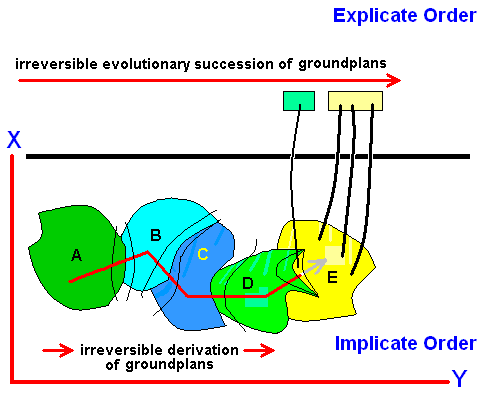
Figure 11k : Lower Quarternary stage. The red line segment indicates where in the succession of noëtic derivations we are.
We have left the proper stability field of groundplan D, but the latter can still metastably exist. Therefore it still projects into the Explicate Order, albeit in a condition of decline there. Groundplan E is stable and projects into the Explicate Order where it occupies several different ecological niches.
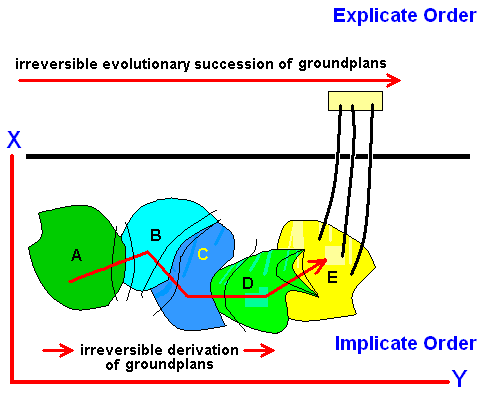
Figure 11-l : Upper Quarternary ( = Recent) stage. The red line segment indicates where in the succession of noëtic derivations we are.
Groundplan D cannot exist anymore, even not metastably so. Groundplan E is (still) stable and still projects into the Explicate Order where it occupies several different ecological niches.
This concludes our diagrammatic example of the evolutionary succession and alternation of groundplans, and how it is based on the ordered derivations of their noëtic contents (one from the other) in the Implicate Order.
In the above diagrams, depicting noëtic stability fields in the Implicate Oder, we have accounted for the phenomenon of noëtic metastability. But, of course, not all groundplans can (noëtically) continue to exist outside their proper stability field. Many of them will be such that they can only exist within their proper stability field, and not beyond it. Things can also be the other way around : some (or many) groundplans are such that they can metastably exist far beyond their proper stability field (as we see it also within the confines of our physical and mineralogical analogue, in certain minerals : For example Diamond (which is one of the polymorphs of Carbon) is very stable not only under conditions of high pressure and temperature (under which conditions it is naturally formed) but also under ordinary pressures and temperatures (atmospheric conditions) even though thermodynamically the stability diagram of the phases of Carbon shows that Graphite (another polymorph of Carbon) is the stable phase).
In organisms this large range of metastability is seen in the persistence of many old and primitive groups. In Diptera, for example, we have the fungivoroids, as we see them existing in the recent fauna in the form of several closely related families (centering around the Fungivoridae (fungus-gnats)). But fungivoroids are known to have existed already in Jurassic times, that is, relatively not long after the origin of the Order Diptera itself. So the fungivoroids have, at least as a definite type of diptera, persisted, and still persists, alongside the many younger groups of diptera that have originated since Jurassic times. We can confidently assume that the fungivoroids still exist metastably, and have done so since, say, lower or middle Cretaceous times.
When, in the Implicate Order, a given groundplan turns out to be not noëtically derivable from any other, existing, groundplan, then, when it nevertheless does exist, it is a new groundplan, having resulted from a noëtic reaction between two or more other noëtically existing groundplans, or it is the product of a noëtic reaction between a number of elementary reactants. This product, a new groundplan, appears precisely 'there' ( = noëtically there) in the Implicate Order where the noëtic conditions are such that the product is more stable than the elementary reactants.
As a whole, the series of the above diagrams (Figures 11a--11-l) also shows that, and how, the different families (in the diagrams represented schematically and in a general way only) evolutionarily (that is, in the Explicate Order) appear polyphyletically, one after the other (in parallel lines), and (the series also shows) that within each (larger) family itself its members appear in parallel lines too. So, according to this scenario, there is no ancestral tree of families (nor one of genera and species within each family). See Figure 10 above , and also next Figure :
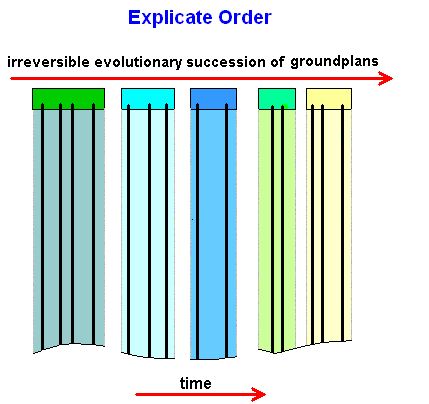
Figure 11-m : Polyphyletic, that is, independent origin of five families (such as dipterous families).
The groundplans of five different families have (as it seems, independently) projected from the Implicate into the Explicate Order. They 'bring with them' their special existential conditions resulting in the fact that each one of them is going to occupy a series of ecological niches (that is, it radiates into a series of different species). In the Explicate Order we 'see' this as the appearance of these five families one after the other, and we then deduce that they, or at least their groundplans, had monophyletically originated from each other :
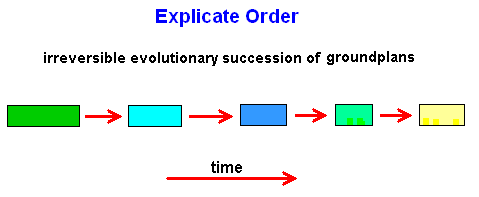
or perhaps :
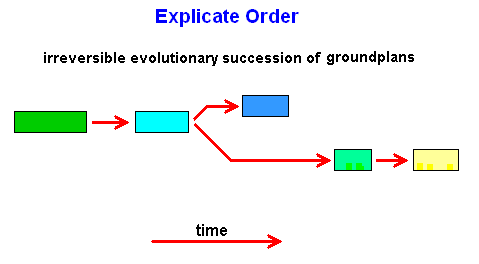
The above two diagrams express the supposed (monophyletic) evolutionary descent of one (or more) family from another. They depict when (in the geologic history) each family appeared for the first time and from what other family it came from. Generally, if a new family develops from an old one, the latter keeps on existing alongside the new one, because such an origin began with the splitting up of an ancestral species into two species, one of which strongly deviates from the ancestral species and thus being destined to develop the new family.
And this is how we appear to see things in the Explicate Order, that is, we see (or deduce) the descent of one family from another, resulting in a genealogical tree of families. And this tree has still finer branches because each family is itself supposed to have developed according to its tree of genera and species. But in fact we have now understood that the families do not historically and materially originate from each other but appear in the Explicate Order independently. It is only in the Implicate Order that their respective groundplans originate from each other, that is, are noëtically derived one from the other, along the noëtic trajectory as was described and figured above.
Note on the comparison with the hierarchic phylogenetic system of taxa.
We can express the same thing a little differently : In the Explicate Order there is no m a t e r i a l generation of one family from another (and the same applies to all lower- and higher-ranking taxa). Nevertheless, they do originate one from the other. But that takes place in the Implicate Order where they are immaterially generated, one family from another. And this means that if we look for a genealogical tree (or trees) we must look for it in the Implicate rather than in the Explicate Order. In the latter Order the only lines that have something to do with the origin of taxa are the lines of projection. These lines are the imaginary lines along each of which a noëtic pattern (such as a groundplan, or a(nother) noëtic reaction product) projects from the Implicate Order into the Explicate Order resulting in the pattern's unfolding along space and time dimensions. When we now theoretically trace some given organisms back to their origin, we, in the Explicate Order do this tracing-back along the lines of projections, instead of along the time line. And as long as we are in the Explicate Order these lines of projection do not converge, they remain parallel. Only in the Implicate Order these lines will, at least in many cases, converge, as we can see it in Figure 10 given above (click HERE to see this figure and its original subscript) and reproduced here :
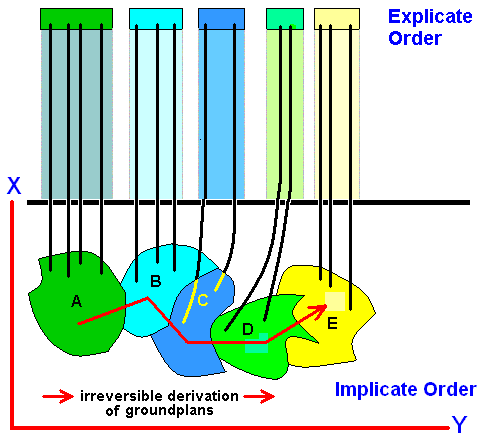
Figure 10 (reproduced and slightly altered) : Here we have -- in the Explicate Order -- five independent lines or bands of projection (each made up of a number of actual (similar) projections), see also Figure 5 above . In the Implicate Order, however, they converge on one and the same noëtic trajectory (red line) along which the noëtic contents of five family-groundplans are successively derived : Groundplan E from groundplan D, groundplan D from C, C from B, and B from A, and then projected. Cladistically we can depict this as follows :
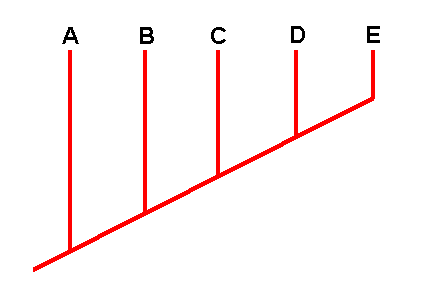
Figure above : Things of Figure 10 are here expressed in the form of a cladogram : The oblique line represents the noëtic trajectory (in the Implicate Order) along which the (noëtic content of the) family-groundplans irreversibly derive from each other. On the other hand, the vertical lines represent the successive projections of the noëtic contents of the (derived) groundplans (together with those of their adaptive structures) from the Implicate into the Explicate Order.
This looks pretty much like the familiar cladograms used in phylogenetic systematics. The difference is to be found in the direction of the time dimension and its absence in the Implicate Order :
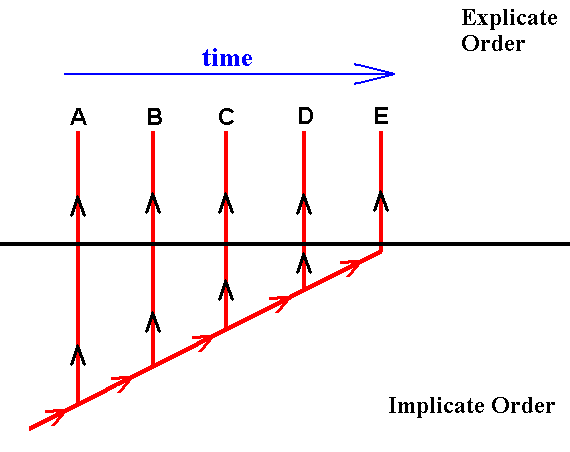
Figure above : In the Explicate Order we see the successive, and apparently independent, appearance of five family-groundplans. In the Implicate Order we see the noëtic derivation of the groundplans, one from another. In the Explicate Order one family-groundplan after the other projects into it from the Implicate Order, one after the other, that is, along the time dimension. The origin of these groundplans cannot, however, be found by tracing back along the time dimension, but along the dimension along which the projection of them takes place. And then, in the Implicate Order these lines of projection converge upon the noëtic trajectory along which the groundplans are noëtically derived. That is to say, all five projection lines originate from the one noëtic trajectory. So if we follow these groundplans -- as presented by living species in the Explicate Order -- all the way down into the Implicate Order we discover their origin and interconnection, and in this way obtain a cladogram of the family group, indicating this group to be a monophyletic one.
Also each family itself is a monophyletic group of species (each one of these occupying a different ecological niche). And also here we only find this out when tracing the species all the way back into the Implicate Order, see Figure 5 above .
Noëtic trajectories
Again using the analogy between the noëtic derivation of groundplans and physical phase transitions we can imagine that in the Implicate Order there are many noëtic trajectories. For the case of mineral stability diagrams this is clear :
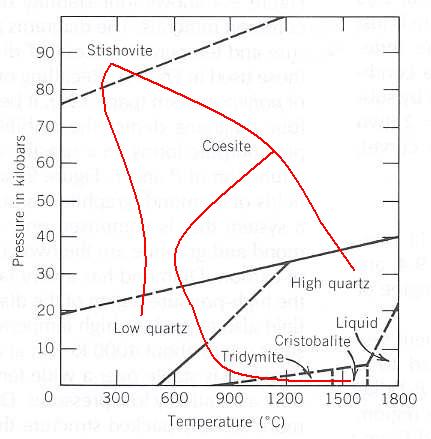
Figure above : (from Figure 18 Part XXIV) : Mineral stability diagram (P-T diagram) of the system SiO2.
When black curves or lines, are solid their locations have been determined with certainty. When they are dashed, their location is less well known.
A kilobar = 1000 bars. 1 bar = 0.987 atmosphere.
In this mineral stability diagram we have added some possible trajectories (red curves). Such a trajectory represents a gradual and ongoing change in temperature and pressure. Following such a change we get from one stability field to another:
Beginning (as just an example) in the stability field of Stishovite we enter that of Coesite and end up in that of low Quartz. Another such temperature-pressure trajectory might be :
Also beginning in the stability field of Stisthosite we enter that of Coesite and end up in high Quartz. And another such trajectory might be :
From Stisthosite to Coesite and then to low Quartz and from there to Tridymite, finally ending up in the stability field of Cristobalite.
(Adapted from KLEIN & HURLBUT, 1999)
Now let us work out something like this for groundplans in the Implicate Order :
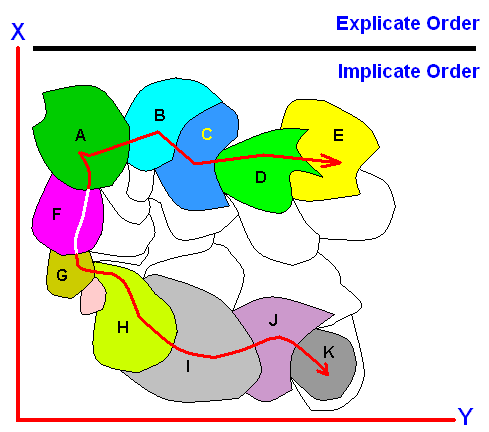
Figure above : Stability fields and noëtic trajectories in the (abstract) X / Y space of the Implicate Order.
Shown are two noëtic trajectories, both starting from A, that is, from the noëtic stability field of (the noëtic content of) family-groundplan A.
The first noëtic trajectory successively visits the stability fields of groundplans B, C, D, and E. The second noëtic trajectory successively visits the stability fields of groundplans F, G, H, I, J, and K.
The non-colored fields bordering the groundplan stability fields are stability fields of elementary noëtic reactants. In each such a field certain elementary noëtic reactants are noëtically stable (and thus noëtically exist there), while their reaction product is not. This reaction product is the noëtic content of some groundplan, and this content is stable in the groundplan's noëtic stability field. The next Figure illustrates this for one groundplan :
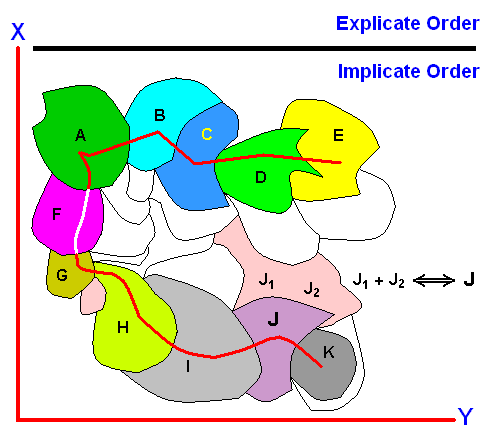
Figure above : Stability fields of groundplans and elementary reactants and noëtic trajectories in the (abstract) X / Y space of the Implicate Order. The stablity field of one groundplan -- groundplan J -- and the stability field of its elementary reactants J1, J2, are highlighted to illustrate stability fields of groundplans (reaction products) and those of their corresponding reactants.
For this purpose we here consider the noëtic reaction J1 + J2 <==> J ( The sign <==> means that the reaction can proceed in one direction or in the opposite direction, depending on the prevailing noëtic conditions, symbolized by the values of X and Y ). In the flesh-colored field the noëtic reactants J1 and J2 are stable, that is, more stable than their reaction product J which is the noëtic content of groundplan J, so the reaction will not get started, or, equivalently, we will have J ==> J1 + J2. On the other hand, in the dark-red-brown-colored field J the reaction product J is more stable than the reactants, forcing the reaction to proceed from the reactants to the product : J1 + J2 ==> J.
Independently of the above two noëtic trajectories there can exist other such trajectories, one of them is depicted in the next Figure :
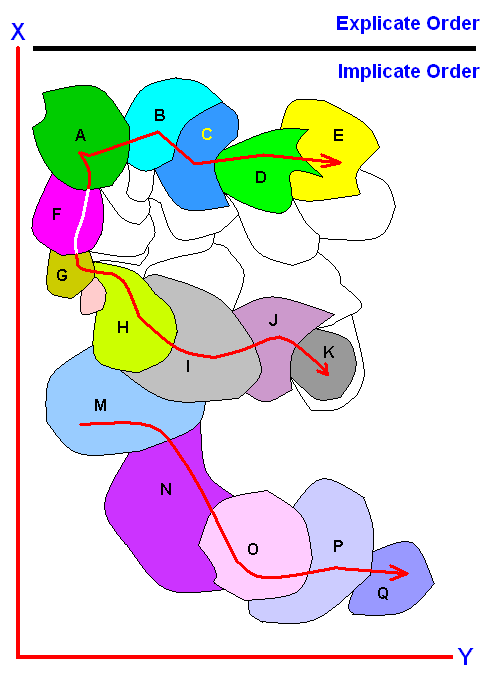
Figure above : Stability fields of groundplans (and of reactants) and noëtic trajectories in the X / Y space of the Implicate Order.
In addition to the two noëtic trajectories given above, we have drawn one more such trajectory which is independent of them. This trajectory respectively visits the stability fields of the groundplans M, N, O, P, and Q.
The groundplans, of which the stability fields of their noëtic content were presented diagrammatically in the above Figures, are meant to be family-groundplans. And as we know, such a noëtic content is projected into the Explicate Order along a projection line or band. And each such a projection line itself is usually made up of a bundle of subordinated projection lines each ending up in some different ecological niche.
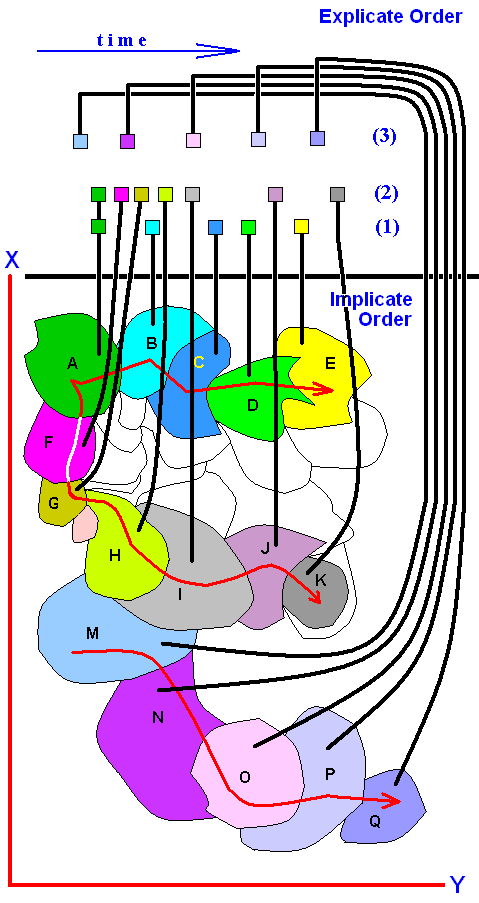
Figure above : Noëtic stability fields and noëtic trajectories (red lines) in the Implicate Order, and successive projection (into the Explicate Order) of the noëtic content of the family-groundplans along the three noëtic trajectories. Each projection is indicated by a heavy black line or curve. As a result of the projections three series, (1), (2), and (3), of family-groundplans appear in the Explicate Order. Each such a series is an ordered sequence of family-groundplans. And each such a groundplan carried with it the specific existential conditions in order for it to be able to appear in some corner of the Explicate Order.
Series (1) and (2) both have, in the Implicate Order, their starting point in the noëtic content of groundplan A, while seies (3) starts from the noëtic content of groundplan M.
Noëtic reactions
The Implicate Order is a highly dynamic order of Reality because of the omnipresent noëtic reactions. Perhaps we can say that the Implicate Order IS a giant dynamical system. And this system consists of a multitude of noëtic reactions that essentially are transformations of given immaterial patterns into other immaterial patterns. In order to be able to imagine the very essence of a noëtic reaction, all we can do is think about chemical reactions (as we can observe them in the Explicate Order) : If a number of chemical reactants, say A, B, and C, (in the form of atoms or molucules) are (1) within material reach of each other (meaning that they are spatially close enough to each other in order to be able to chemically interact), and (2) when, in addition to that, the ambient conditions are such that one or another possible chemical reaction-product, say the product P, is more stable than the reactants, and (3) when, in the case of the presence of an energy barrier, there is enough activation energy available to breach the barrier, then the reactants A, B, and C, will chemically interact resulting in the chemical reaction-product P. We then have the reaction :
If there is not enough activation energy available the reaction will fail to get started and the reactants will continue to exist, but now in a metastable condition.
If, on the other hand, the reaction-product P exists under ambient conditions such that the reactants A, B, and C are more stable than the product P (and than whatever reaction-product), then, when the reaction is reversible at all, the product P will disintegrate, that is, it breaks down into the reactants A, B, and C ( If the reaction is not reversible at all, the product P is stable with respect to the reactants A, B, and C ). The reaction then is :
We had assumed that for the first reaction to get started activation energy was needed. When, on the other hand, it is needed for the second reaction instead of the first, and when, in addition to this, not enough such energy is available, then the second reaction will fail to get started and the product P will keep on existing, but in this case only metastably so.
In this kind of chemical reactions new molecules are formed (while precisely the same atoms are involved). Other chemical (or, if one would prefer, physical) reactions are such that the chemical formula is the same before and after the reaction. This is the case in all polymorphic transformations as discussed in the previous document. What is transformed in such reactions is the crystal structure. The chemical substance remains the same. This is where phase-stability diagrams come in, such as that for H2O (the different Ice structures), for SiO2 (the different SiO2 minerals), etc.
All these reactions are material. They proceed in space and time, and therefore belong to the Explicate Order and not in any way to the Implicate Order. But we can -- in fact we have to -- use them as analogues of the very noëtic reactions, which are immaterial, spaceless and timeless, that make up the Implicate Order. And we have already done so for the case of the derivation of given noëtic contents of family-groundplans from noëtic contents of other family-groundplans.
Let us specify this analogy between chemical reactions and noëtic reactions still further.
The stability fields of reactants and reaction-products in chemistry are the ranges of thermodynamic variables within which they can exist stably. A given reactant or product is in a state of containing minimal potential energy when the ambient thermodynamic conditions fall within its stability field. It can then physically exist. Analogously, a given noëtic reactant or product can only stably exist (in the Implicate Order) when the noëtic conditions fall within its noëtic stability field. But here the reason that it stably exists is not because it then contains a minimum potential energy, because energy is a typical physical magnitude, not a noëtical magnitude. The place of minimal potential energy is in the Implicate Order taken by something like qualitative coherence (which might be equivalent to internal mathematical consistency). And under certain 'ambient' noëtic conditions a given noëtic pattern (a noëtic reactant or product) has the greatest possible qualitative coherence. And here "ambient" is not spatially meant (as it is in the Explicate Order) : Physical space is made up of spatial distances (between physical objects). And noëtic space is also made up of distances. But here "space" is not physical space, and "distances" are not spatial distances. Distances here are the formal differences between given qualitative contents or patterns. And so while in the Explicate Order "ambient" means physically contextual (ambient physical conditions of some given physical pattern = its physical context or setting), in the Implicate Order it means qualitatively contextual (ambient noëtic conditions of some given noëtic pattern = its qualitative context [not to be confused with qualitative content] ). So in the Implicate Order the qualitative context of some given noëtic pattern (a noëtic reactant or product) determines whether that pattern is noëtically stable, and can thus noëtically exist, that is, whether it is maximally qualitatively coherent (or internally mathematically consistent).
From all this it follows that the stability fields of given physical substances or (mineral) phases, as they are presented in the physical or mineral phase diagrams, do not express where in concrete physical space (that is, in what locations) we can find these substances or phases, but express 'where' in the abstract 'thermodynamic variable space' we can expect them to exist. Here, that is, in the Explicate Order, we have the duality of (1) spatial location and (2) thermodynamic conditions, that is, we have two 'spaces', one of them is concrete physical space, while the other is abstract thermodynamic variable space. And some given physical substance or phase can in principle be present in any spatial location where there is physical room for it, but actually it can only exist in such a location when certain thermodynamic conditions prevail there. In contrast with this, the stability fields of given noëtic patterns (noëtic reactants or products) in the Implicate Order do express under which noëtic conditions these patterns can exist, but at the same time express 'where' these patterns will be found (because here there is no spatial location in addition to the 'location' in the space of conditions). Here "where" means ambient noëtic conditions (qualitative context) as well as 'where' in noëtic space. That is, the qualitative c o n t e x t (= ambient noëtic conditions) of a given noëtic pattern (= noëtic content) = its ' location ' in noëtic space, i.e. 'where' in the Implicate Order it noëtically (and stably) exists. So the noëtic stability field of a given noëtic pattern indicates 'where' in the Implicate Order we can find that pattern.
And now we can understand the nature of noëtic reactions much better : Precisely THERE in the Implicate Order (= noëtic space) where the noëtic reaction-product nP of the noëtic reaction nA + nB + nC ==> nP is noëtically more stable (because it is qualitatively more coherent) than the corresponding noëtic reactants nA, nB, and nC, will it appear as a result of the noëtic reaction nA + nB + nC ==> nP, while, as is to be expected in the Implicate Order, these reactants will not be used up (which is typical of the Explicate Order only, to which volumes and numbers typically belong), but will keep on existing in their respective noëtic stability fields. And, conversely, precisely THERE in the Implicate Order where the noëtic reactants nA, nB, and nC of the noëtic reaction nP ==> nA + nB + nC are more stable than the reaction-product nP, they will appear in their common (or respective) noëtic stability field(s) as a result of this noëtic reaction. In all this, the expression "they will appear" in fact means they exist.
And the same of what has been said applies to the reactants themselves, because they in turn are the products of other reactions. So all existing noëtic contents or patterns are the products of certain noëtic reactions. And although noëtic reactions do not take place in space and time, we can confidently say that the Implicate Order is an intrinsically d y n a m i c entity, that is, an entity or range consisting of immaterial ('abstract') dynamical systems and their respective dynamic attractors to which (latter) noëtic trajectories are necessarily drawn and come to rest ( Abstract dynamical systems and their attractors are dealt with extensively in First Part of Website ). And the trajectories of these immaterial dynamical systems, that is, the sequences of successive states through which the system passes, are exemplified by the above discussed "noëtic trajectories" depicted as red lines in figures given earlier (see for example HERE ). The just mentioned examples referred to the succesive transformation of groundplans. And indeed, also such a transformation is a noëtic reaction (comparable with a chemical polymorphic reaction). It is a noëtic reaction with, so to say, one reactant (and one product). And, as we now know, in addition to such reactions there are those that involve more than one reactants together generating one noëtic product. One (also generally expressed) example of this type of noëtic reaction we also already mentioned above : The generation of the noëtic content of a given organic groundplan from elementary noëtic reactants, see HERE . On the basis of all this we can imagine that the events in the Explicate Order -- especially those of organic evolution -- are, at least for an important part, the physical expression of the immaterial dynamic of the Implicate Order.
And, finally, from all the above it is clear, but important enough to be mentioned once again, that the structure of the noëtic stability landscape (as we can depict it in the stability diagram) is something entirely different from the structure of some given noëtic pattern (for example an organic groundplan) existing in this landscape.
Noëtic reactions and the existence and origin of taxonomically isolated groups of organisms.
While studying the evolution of some group of organisms (where we here think of the insect Order Diptera and its families), and taking into account the Implicate Order, we indeed have seen in what way the evolutionary succession of family-groundplans, as observed in the Explicate Order, is a material expression of the serial formal derivation of the noëtic contents of one groundplan from that of another (proceeding) in the Implicate Order. On the basis of what we observe and measure in the Explicate Order we are in such cases more or less able to formally derive, not simply one family from another, but one abstract family-groundplan from another such groundplan. But we know that such a derivation does not exist in a material form, that is, does not take place in the Explicate Order, but immaterially in the Implicate Order. However, in the biological world there are indications that in addition to the origin of families from each other (that is, a linear sequence of family-groudplans) there exist families that seem to be isolated. Examples are the family Mycetobiidae, the family Pachyneuridae, and some other nematocerous families. But these nevertheless show a number of affinities with fungivoroid or bibionoid types. A better example of a taxonomically isolated family is the family Nycteribiidae which are dipterous ectoparasites of bats (described and discussed in Part XXVI (next document)). Despite them being true Diptera, these insects do not at all look like flies. They are permanently wing-less and look like spiders :
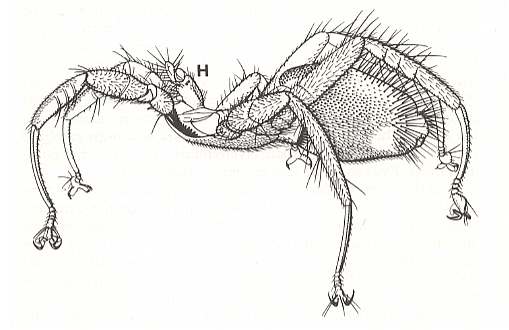
One could be tempted to ascribe all features of this animal to its adaptation to an epizoic life (= living on the body of animals) on bats. However, there is yet another dipterous family, namely the Streblidae (see next document), of which the representatives also live on bats, but, -- although they also possess adaptive structures, adaptive that is, for being epizoic on bats, -- their morphology is totally different from that of Nycteribiidae and they still look like flies. So it is hard to believe that all features that make the Nycteribiidae deviate from true Diptera -- deviate, that is, from the order-groundplan Diptera (and even from the groundplans of all known dipterous families) -- are necessary adaptive structures making possible an ectoparasitic life on bats, adaptations, that is, that cannot be replaced by other equivalent adaptations to such a life. So a number of these features (letting Nycteribiidae deviate from true Diptera) is not adaptive but formal. And this means that these features are the result of formal derivation in the Implicate Order. But we cannot mention a dipterous family-groundplan from which these features could possibly have been derived. They seem to have been derived directly from the order-groundplan. And thus the whole Nycteribiid family-groundplan could have been formally (that is, in the Implicate Order) derived from the order-groundplan. But if this were true, then all other dipterous families could have been equally so derived, while the morphologies of these families at least suggest some possibility of derivation from each other (albeit having actually taken place only in the Implicate Order) meaning that they are only indirectly derived from the order-groundplan. So we must conclude that the formation of the Nycteribiid family-groundplan must have involved the Explicate Order (too). That is, the Nycteribiid family-groundplan was not simply noëtically derived from the order-groundplan, but the noëtic content of the order-groundplan has noëtically reacted with the noëtic content of the ecological niche consisting of a (bloodsucking) life on the body of bats. How can we imagine all this ?
Additional elaboration of the concept of the organic Groundplan.
A groundplan, or prototype is the complete set of prototypic characters explicitly or implicitly present in all organismic individuals of a given taxonomic group of given taxonomic rank.
Prototypic characters are characters that are primitive, that is, original.
Metatypic characters, on the other hand, are derived characters, derived from primitive characters or from other metatypic characters (derived by transformation or reduction), or they are added characters, as is the case in the appearance of new organs such as wings (in originally wingless insects). Metatypic characters do not belong to the groundplan.
The total complex of prototypic characters, constituting the groundplan, has no special adaptive nature. The groundplan has at most a general adaptive nature in the sense that it is suitable to become adaptive, that is, to acquire adaptive structures gearing with one or another ecological niche from a large, but delimited, set of potential ecological niches. This set of its potential ecological niches is precisely determined by the groundplan.
Characters are prototypic or metatypic only with respect to a given taxonomic category (say a genus or family). Let us give an example.
For the phylum of Articulata (segmented animals, such as many worms, lobsters, spiders, and insects) segmentation is a prototypical phylum-character. The appearance of jointed legs is for it (that is, for the phylum Articulata) just a metatypical character. But for the subphylum Arthropoda (Articulata with jointed legs) it is a prototypical (subphylum-) character.
Metatypical characters can become prototypic when we descend to (groups having) a lower taxonomic rank.
A prototypic character is considered as such (i.e. to be prototypic) also in all lower taxonomic ranks (subsumed under the one higher taxonomic rank in which the character appeared as a prototypic character for the first time in descending from higher to lower taxonomic rank), although in these lower taxonomic ranks such prototypical characters can often monophyletically or polyphyletically become transformed or even partly or completely reduced.
The groundplan (prototype) of a given taxonomic stage or category (in the taxonomic system of a given animal group) is, as has been said, the complete set of prototypic characters of that taxonomic category. Phylogenetically such characters are older than the metatypical characters. The prototypes are at the same time paleotypes, the phylogenetic correlates of which are the ancestral forms that actually have existed. Upon ascending in the taxonomic system (to higher-ranking groups) these proto- or paleotypes -- as they are specified by theory -- become ever more poor in content, that is, at least poorer than the concrete ancestral forms because these latter also should have possessed for the given taxonomic rank metatypic characters, which we generally cannot specify without the help of fossils.
Although the prototypical characters of the higher taxonomic categories, as being relatively old characters, had at their disposal a longer period for further morphological development, and were for a longer time subjected to natural selection, they definitely are not in all cases in a stronger degree adaptive and functional. Indeed, of the oldest, the " stylistic principles" of formation one often has said that they resist any functional interpretation, and that clear-cut "adaptive" characters are often relatively young (WEBER,H., Grundriss der Insektenkunde, 1966, p. 207).
Because metatypic characters can appear by transformation of (parts of) prototypic characters, as well as by addition of completely new characters, the groundplan (prototype) tends to be masked in a stronger or lesser degree by these (metatypic) characters. The pure and complete groundplan (of a given taxon) is, upon inspection of a concrete animal, seldomly as such apparent, especially the groundplans of the higher taxonomic groups to which that animal belongs. But in most cases some part of it is apparent : An insect of the family, say, Ephydridae (we not yet being aware of it) might present difficulties as to what family, and especially as to what genus and species it properly belongs, but that it is a member of the Order Diptera is, in the majority of cases, at once clear, and, of course the same applies to the fact that it is a member of the Class Insecta.
So in a concrete animal, or in a species, the groundplans of the higher taxonomic groups (family, superfamily, suborder, etc.) to which it belongs are more or less masked by metatypic characters. Diagrammatically this can be expressed as follows :
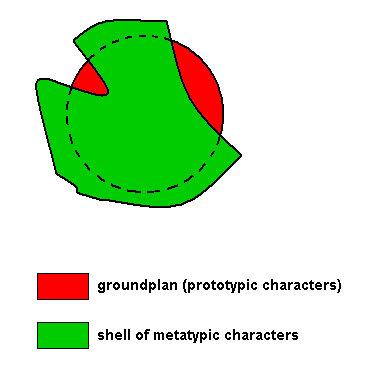
Figure 12 : The groundplan, here depicted as a red disc, is partly covered, and even partly replaced, by a shell of metatypic characters (green). Only some parts of the groundplan (that is, only a small number of prototypic characters) is visible from the outside.
Only as such, that is, only when provided with a shell of metatypic characters among which there must be some that are adaptive with respect to some existing ecological niche, can a groundplan exist in the Explicate Order. In the Implicate Order, however, it can exist as the noëtic content of a pure and complete groundplan :
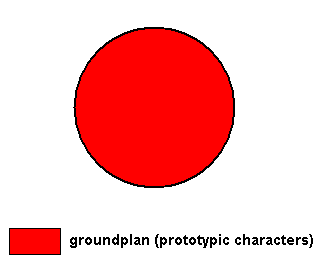
Figure 13 : The groundplan (red disc), can, and does, as a pure and complete groundplan, exist in the form of a noëtic pattern in the Implicate Order, alongside its 'clothed' version (as in the previous Figure), that is, the latter also exists in the Implicate Order in the form of a noëtic pattern.
If we now consider the groundplan (prototype) of a one-step-lower taxonomic group, which is thus one of the subgroups of the group considered in the previous two Figures, we see that the metatypic characters of the original group have now become prototypic characters of the subgroup, that is, they, together with the original prototypic characters, make up the groundplan of this subgroup. See next two Figures.
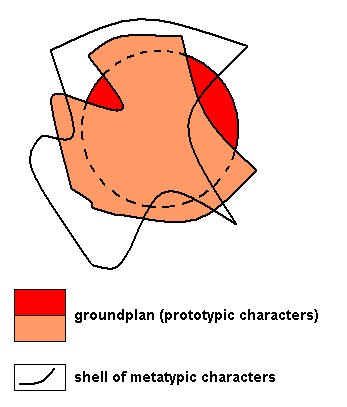
Figure 14 : The metatypic characters of the group have become prototypic characters of the subgroup. Also the original prototypic characters are prototypic characters of the subgroup. All the prototypic characters together (both shades of red) constitute the groundplan (prototype) of the subgroup. The outline of the shell of new metatypic characters (metatypic for the group as well as for the subgroup) is indicated. See also next Figure.
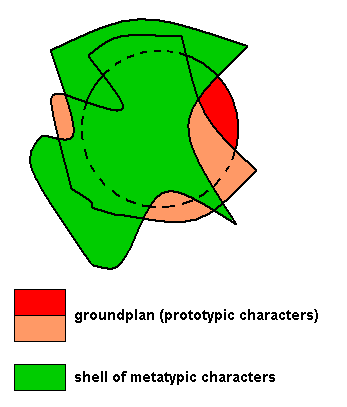
Figure 15 : As in previous Figure : The metatypic characters of the group have become prototypic characters of the subgroup. The groundplan (both shades of red) of the subgroup is more or less masked by the new metatypic characters (green).
The relationship between the order-groundplan (Prototype of Order) and family-groundplan (Prototype of family).
When speaking of "Order" or "family" we -- in the present website -- first of all think of insect taxa, and especially those connected with Diptera. It is to be expected that an insect Family and insect Order are far from equivalent to Families and Orders in other animal groups such as in Vertebrates, in Molluscs, or in Echinoderms, let alone in plants or in micro-organisms. It is sufficient to see a 'family' as representing a natural group of related animals, but not just any such group, but a group just above the species and genus level. An 'order' then also represents such a group, but now a group above the family level. This is still very vague, but not as such disturbing, because the discussion is supposed to be general, implying that while 'family' and 'order' do very well in our theoretical discussion when they happen to be insect families and orders, other ranks do perhaps much better when discussing examples taken from other animal groups, and this will not change the meaning of the concept "groundplan" or "prototype" .
Every family-groundplan contains as its penultimate kernel the order-groundplan :
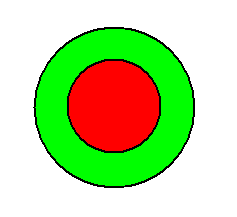
Figure 16 : Schematic representation of family-groundplan. To the qualitative content of every family-groundplan also belongs that of the corresponding order-groundplan. The latter (red) forms the qualitative kernel of the former. In the Implicate Order the family-groundplan can be involved in one or another noëtic reaction, but its kernel, the corresponding order-groundplan can also, all by its own, be involved in some noëtic reaction. The qualitative wholeness of the order-groundplan is not diminished by the fact that it is a part of another qualitative wholeness, the family-groundplan. Further we can, of course, say that where in the Implicate Order a given family-groundplan is noëtically stable the corresponding order-groundplan is also stable.
The noëtic stability fields of the family-groundplans of a given order, say those of all the dipterous families, that is, all the families belonging to the insect Order Diptera, are expected to more or less form a cluster in the Implicate Order (because they are qualitatively similar). And this cluster then constitutes the noëtic stability field of the order-groundplan. Directly outside this field and adjacent to it we are expected to find stability fields of elementary noëtic reactants that, upon noëtically reacting, produce one of the dipterous family-groundplans. But these are not the only noëtic entities that we find outside this field. We will, in addition to them, find noëtic stability fields of family-groundplans belonging not to the Order Diptera, but to one or another different insect Order, among which the Order Mecoptera (scorpion-flies) which is supposed to have given rise to several insect Orders, among which the Order Diptera. So when we travel around in the cluster of stability fields of dipterous family-groundplans, that is, in the overall stability field of the Order Diptera, we sooner or later will cross the order-boundary and thus enter the stability field of another Order (by in fact entering the stability field of the groundplan of a family not belonging to the original Order but to that other Order). In all this we must realize that -- as has been expounded above -- in the Implicate Order the stability field of some given groundplan (or any other noëtic pattern or content) is at the same time the ' location ' in the Implicate Order where we can find the noëtic content of this groundplan.
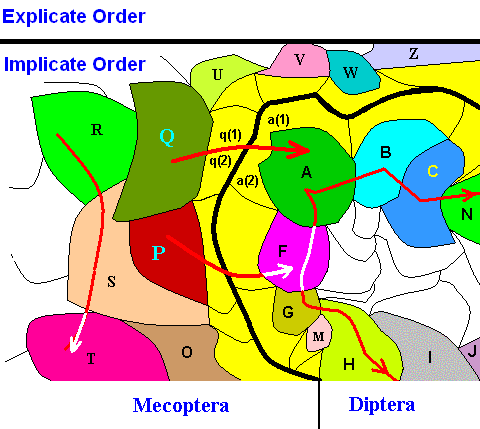
Figure 17 : Region of the Implicate Order where we see parts of the noëtic stability field of both the dipterous and mecopterous order-groundplan, separated in the diagram by a heavy black curve. Each order-groundplan stability field is partitioned into a large number of subordinated stability fields where these latter comprise family-groundplan stability fields (indicated by several colors in the diagram) and the stability fields of elementary reactants (yellow), which latter can, upon having noëtically reacted with each other, generate family-groundplans. Also indicated are several noëtic trajectories (red curves) leading from one family-groundplan to another. Two of these cross the boundary between the noëtic stability fields of the two order-groundplans, viz., that of the Order Mecoptera and the Order Diptera. We have drawn two of them, as such expressing a diphyletic origin of the Order Diptera from the Order Mecoptera. What we mean by this, however, is to emphasize the theoretical plausibility at all of a polyphyletic origin of the Order Diptera from the Order Mecoptera.
The part of the stability field of the Mecoptera order-groundplan that is actually shown in the diagram, (that is, this particular diagram) consists of 10 stability fields of mecopterous family-groundplans indicated by capital letters : O, T, S, P, Q, R, U, V, W, and Z. And in addition to these family-stability fields there are stability fields (yellow) of the elementary reactants, which, upon reacting with each other, generate the respective mecopterous family-groundplans. These reactant stability fields can be anywhere in that of the Mecoptera order-groundplan. However, they are especially present in the border area of the order-groundplan.
On the other hand, the part of the stability field of the Diptera order-groundplan that is actually shown in the diagram, consists of 10 stability fields of dipterous family-groundplans indicated by capital letters : J, I, H, M, G, F, A, B, C, and N.
And again, in addition to these family-stability fields there are stability fields (yellow) of the elementary reactants, which, upon reacting with each other, generate the respective dipterous family-groundplans. These reactant stability fields can be anywhere in that of the Diptera order-groundplan. However, they are especially present in the border area of the order-groundplan.
As has been said, in the diagram we have drawn -- as examples -- two (unidirectional) noëtic trajectories that cross the Mecoptera-Diptera boundary. One goes from the stability field of the mecopterous family-groundplan Q and ends up in the stability field of the dipterous family-groundplan A. The other trajectory goes from P to F.
Let us describe the first one in more detail (for the second the same considerations apply) ( If necessary, click HERE to have easy access to the above Figure) :
In the beginning the noëtic trajectory Q-A is in the stability field of the mecopterous family-groundplan Q. This groundplan exists there as a result of the noëtic reaction q(1) + q(2) ==> Q. Upon leaving this field the trajectory enters the stability field of the elementary reactants q(1) and q (2). This is the field where both q(1) and q(2) are noëtically stable. Consequently they exist there as a result of the noëtic reaction Q ==> q(1) + q(2), while their reaction product Q cannot exist there. After this the noëtic trajectory leaves the stability field of q(1), q(2), and with it (leaves) the stability field of the mecopterous order-groundplan, and enters into that of the dipterous order-groundplan. Specifically, it is now in the stability field of the elementary reactants a(1) and a(2). Here both reactants are noëtically stable and indeed exist here as a result of the noëtic reaction A ==> a(1) + a(2). The dipterous family-groundplan A cannot exist here because here it is noëtically unstable. Finally, upon the noëtic trajectory entering the stability field of the dipterous family-groundplan A, this groundplan indeed exists here, while the elementary reactants a(1) and a(2) do not, as a result of the noëtic reaction a(1) + a(2) ==> A.
The differences and interconnections between the Implicate and Explicate Orders.
The one and only Reality, that is, Reality, or Being as a whole, is supposed to consist of two ontologically different domains or orders ( By "ontological" we mean way of being in the most fundamental sense, for example material or immaterial way of being.) :
However, different as they are, these two ontological domains do not split up Reality in two disparate realites. They are interconnected, resulting in one single Reality.
We have already spoken of projection. When a given noëtic pattern or content unfolds itself in the Explicate Order, it is said to project (or being projected) from the Implicate Order into the Explicate Order. It does so by becoming unfolded along space and time dimensions, resulting in it appearing as a physical pattern. The projection of a noëtic pattern into the Explicate Order does not result in the loss of it in the Implicate Order ( We can hold that merely a copy of it is projected).
Injection, on the other hand, (of which we have spoken only a few times) is the reverse process : When a physical (or biological) pattern is being enfolded along space and time dimensions -- thereby becoming immaterial -- in the Implicate Order, it is said to inject itself (or being injected) from the Explicate Order into the Implicate Order. Also in this case injection of a pattern from the Explicate Order into the Implicate Order does not result in the loss of this pattern in the Explicate Order : Also here we can think of a copy of that pattern being injected.
And this projection and injection goes on all the time ( The temporal aspect, as in 'successive' projection, can, of course, only be experienced as such in the Explicate Order.) : The two Orders are interconnected, and communicate with each other, as a result of these constant projections and injections across the common interface of the two Orders. This fact can also be expressed by saying that the two Orders are constantly exchanging information to each other.
Continuing adaptation in a changing environment, described and clarified in terms of the Explicate and Implicate Orders.
The just supposed and expounded ontological structure of Reality, namely the supposed fact that it consists of two ontologically different domains or orders which, by the processes of projection and injection, exchange information, can clarify the evolutionary phenomenon of progressing adaptation of a given organismic species to a particular ecological niche (as we see it in the Explicate Order).
A given concrete organism (to which we can point with the finger) is not only an individual instantiation of the groundplan of its species, but also, at the same time, an individual instantiation of that of its genus, family, etc.). As existing in the Explicate Order such a groundplan is always provided with the general conditions for existence in that Order (it must be unfolded along space and time dimensions). And in order to be a living biological organism it must, in addition, be provided with certain adaptive structures, adaptive to one or another existing ecological niche.
Such a concrete organism lives in some environment, that is, its direct surroundings. This environment must be such that it contains the ecological niche proper to its species. The ecological niche of a given species is precisely that part or aspect of the environment (in which its individuals normally live) that consists of those elements or factors, biotic or abiotic, with which the individuals of that species commonly interact. All elements or factors with which the individuals do not commonly interact still belong, it is true, to the environment of these individuals, but not to the ecological niche of the species.
In all this we must realize that when we speak about a given ecological niche as being some specific part or aspect of the environment, we speak about one or another individual instance of it. But in fact we should have in mind not such an instance itself but the ecological niche as such, that is, as it is present in all its individual instances. And only as such, that is, as an abstract entity (but in the Explicate Order only existing in the form of individual instances) we will consider the ecological niche in what follows.
In fact the ecological niche is constantly being determined, and refined, by the precise qualitative nature of the species, that is, by its groundplan (which has 'overwritten' the higher-level groundplans of the genus, family, etc.) and its present shell of adaptive structures.
Changes in the environment, for example when additional animal species (or plant species) arrive and stay there more or less permanently, do not necessarily affect the nature of the ecological niche of the (one) original species we are presently considering. Only when the individuals of that species are going to interact with these new factors on a more or less regular basis (thus excluding here all cases of mere one-off contacts), without being exterminated or driven away, the ecological niche of the species might become somewhat altered, and the species will evolutionarily develop corresponding additional adaptive structures (which will appear concretely in later individuals of it).
Now, in the Explicate Order every transformation of one macroscopic pattern into another takes place on the basis of short-range interactions between individual microscopic particles, and only on this basis. Apart from general physical distributions of particles necessarily constituting definite macroscopic (or microscopic) patterns as a result of physical processes, as in cases of physical self-organization, many existing macroscopic patterns cannot be accomplished by the mere interaction of constituent microscopic particles. To this category especially belong the existence and origin of all complex organic adaptations to specific environmental factors, especially biotic factors. The existence and origin of such adaptations ('smart adaptations') cannot be fully explained in purely physical or chemical terms. They show a kind of rationality and flexibility that is alien to the physical world. And that had been the chief reason why we had introduced the Implicate Order (inspired by David BOHM, and others). And indeed we have described the evolutionary process of adaptation as originating from noëtic reactions taking place in the Implicate Order. Now it is time to work out this issue further, especially in connection with the concept of organic groundplan developed above.
We begin with a given organic groundplan (say a family-groundplan) as it exists first of all in its proper noëtic stability field in the Implicate Order in the form of a noëtic, that is, immaterial, pattern, the pure noëtic content of the groundplan. It also exists there as a noëtic reaction product of this content with the noëtic content of one of its potential ecological niches, as these were determined by the groundplan. And it is this noëtic reaction product, the groundplan now clothed with certain (in the Explicate Order to be called) adaptive structures, that is being projected into the Explicate Order, where it is seen as the individuals of a species that is evolutionarily adapting itself to a specific ecological niche. So the groundplan + its initial adaptive shell has, upon projection (into the Explicate Order), unfolded itself along space and time dimensions resulting in a smaller or larger number of individual instantiations of it, spatially distributed over certain regions the biosphere. And, as has been said, projection of something from the Implicate Order to the Explicate Order does not result in the loss of it in the Implicate Order.
Immediately after projection, injection of this same qualitative content takes place, injection that is, from the Explicate Order into the Implicate Order again, and also here without any loss of it in the Explicate Order. And, again, after this injection, projection of this same content takes place once again, and so on. That is to say, there exists a constant alternation of projection and injection of the same qualitative content. In this way, we might say that the persistence of some given qualitative content in the Explicate Order is sustained by this alternation. This alternation of projection and injection brings about an exchange of information between the Explicate and Implicate Orders. So when conditions in a given ecological niche change, for example by the arrival of individuals of other biological species with which the individuals of the original species interact on a more or less regular basis, this ecological change is communicated to the Implicate Order by the ongoing injections. In fact the species adapted to the original ecological niche now defines an extension of this niche by including the new organismic species that have entered it (but, as has been said, only those with which the original species interacts). And this new definition is now injected into the Implicate Order, where the noëtic content of the groundplan of the original species, or the noëtic content of that groundplan + its original adaptive shell, noëtically reacts with the injected new definition of the species' altered ecological niche, resulting in a noëtic product consisting of the (noëtic content of the) groundplan PLUS the (noëtic content of the) new adaptive structure. And this noëtic product will be projected into the Explicate Order where we experience it as the species evolutionarily developing extra adaptations (integrating with the original adaptations) gearing with the newly entered species (and for this latter precisely the same applies, because its ecological niche has changed as well).
And, as the injections and projections go on, further changes in the environment of the species with which we are concerned, will be transmissed to the Implicate Order, but only insofar as they alter ecological interactions. In this way we experience in the Explicate Order a progressive adaptation of a given species to a changing environment, by altering the content of its ecological niche.
We now have described the continuing adaptation of a given species to a changing environment by expanding or altering its set of fixed relations with factors in its environment (this set of fixed relations is the species' ecological niche). However, we here have, despite the mentioned changes, considered the type of environment and the type of ecological niche to remain the same. In the next Section we will discuss and describe the successive occupation, by a given family groundplan, of substantially different ecological niches which are to be found in sometimes markedly different environments.
The fanning-out of a family groundplan in the ecological landscape
( Successive colonization of different environments and different ecological niches by a given family groundplan ).
Although this and the foregoing discussions are meant to be general, we always have in mind the Diptera. And when we now concentrate on family-groundplans we have dipterous families in the back of our mind.
It is well known that all the larger animal families (in Diptera, families such as the Limoniidae [short-palped crane-flies], Cecidomyiidae [gall-midges], Chironomidae [dancing midges], Empididae [dancing flies, asilomorphs], Ephydridae [muscoids, acalyptrates], etc.) represent definite morphological types (often already clearly expressed in the wing-venation), but often not clearly fixed ecological types : The groundplan of a given large dipterous family -- like any family- (or higher-rank-) groundplan, although not having a special ecological significance in the sense of being geared with a specific type of environment or ecological niche -- apparently is qualitatively such that it defines, not a single, but a whole set of potential ecological niches with which it is compatible. The ecological niches (and the environments of which they are a part) of this set can be very different, that is, can represent different types. We can call such a set of potential ecological niches the ecological range of the family. Often the respective ecological ranges of different (and often not related) families partly overlap, that is, a substantial subset of ecological niches is common to such ecological ranges ( The precise ecological niches cannot, however, be identical, because different species by definition define different ecological niches, but they can be highly similar).
A given family groundplan can thus -- in the Explicate Order -- gradually colonize all its potential ecological niches. We could assume that the whole set of potential ecological niches of the groundplan, its ecological range, is a priori defined (determined) by the nature of the groundplan : Earlier we had surmised that the groundplan as it (also) exists (but now) in the form of a noëtic pattern or content in the Implicate Order noëtically defines its conditions of existence in the Explicate Order. And after this groundplan has noëtically reacted with the noëtic content of one of these potential ecological niches the reaction-product projects into the Explicate Order, where it is seen as organisms evolutionarily acquiring special adaptations that gear with the ecological niche. However, in this scenario it is not clear in what way the qualitative content of a given potential ecological niche (as it exists in the Explicate Order) appears as a noëtic pattern in the Implicate Order. Well, we can assume that the presence of such a noëtic pattern in the Implicate Order must be the result of incoming information from the Explicate Order. A potential ecological niche in the Explicate Order is not purely in virtue of itself and only itself physically circumscribed or delimited, because there is no such "itself", that is, there are no physical factors active in it that definitely determine for each of its elements to what particular qualitative pattern (i.e. one or another ecological niche or other pattern) it exclusively belongs. This results in the fact that in the Explicate Order a potential ecological niche is not a unity, not a specific qualitative entity, and so it cannot as such be injected into the Implicate Order. It can only be so injected when it is, already in the Explicate Order, qualitatively determined, and thus delimited, by the groundplan (as it is in the Explicate Order) of which it is supposed to be a potential ecological niche. The family-groundplan -- that is, the animals carrying it -- must probe all appropriate parts of the biosophere in order to conquer as much environmental types and ecological niches as possible, that is, to colonize as great an ecological range as possible. Although the qualitative nature of the family-groundplan delimits this range and with it determines the nature of appropriate ecological niches, it determines the nature of these niches only after the fact, dependent upon which ecological patterns are actually present in the biosphere, and upon whether existing environments have changed and have created new possible ecological niches. Only when such information is actually transmitted to the Implicate Order noëtic patterns of potential niches (serving as possible reactants in noëtic reactions) can 'appear' (in the sense of 'can be') in this Order. And the ecological exploration of a given family-groundplan will indeed proceed along these lines :
Initially, in the Explicate Order, the family occupies only a single ecological niche. But its individuals disperse themselves over wide areas and settle in different environments. When settlement in one such a new environment proceeds successfully a new ecological niche comes to be defined as a result of regular and sustained interactions of the individuals, carrying the family-groundplan, with a delimited set of environmental biotic and abiotic elements of the new environment. Now the new ecological niche is delimited (but special adaptations to it having not yet evolved) and as such is now a qualitative unity that can be injected into the Implicate Order where it is going to exist as a noëtic pattern. And now the family-groundplan, as it already noëtically exists in the Implicate Order (as a noëtic copy of the qualitative content of the groundplan as it exists in the Explicate Order), can noëtically react with the injected qualitative content of the new ecological niche. Upon projection of the reaction-product into the Explicate Order we see it as the evolutionary acquisition of adaptational strucures by the family-groundplan, adaptional structures neatly geared with the new ecological niche. And this process can, of course, repeat itself, resulting in the colonization of, and subsequent adaptation to, yet another new ecological niche, and so on. In this way the family-groundplan gradually occupies its whole ecological range. And we know that for some groundplans their ecological range is determined to be wide (as in the family Chironomidae), while in other groundplans it is rather narrow (as in Simuliidae), or limited to just one ecological niche.
The next evolutionary level is the evolution of the groundplans themselves, that is, the successive transformation of one groundplan into another. This was already described ABOVE , using the mineral stability diagrams as an analogue.
In the next document, which contains Part XXV-B, we will continue pursuing the nature of the organic groundplan and its relation to evolution. Particularly interesting in this respect is an extensive comparison of (1) the structure of the pattern of relations between organisms as it is obtained by our interpretation of organic evolution in terms of the Implicate/Explicate Orders, and (2) the structure of the pattern of relations between organisms obtained by following the principles of Phylogenetic Systematics in the sense of Willi HENNIG (1950, 1966).
e-mail :
 ( Please write in ' Subject ' entry : ' METAPHYSICS ', in order for me to be able to distinguish your mail from spam )
( Please write in ' Subject ' entry : ' METAPHYSICS ', in order for me to be able to distinguish your mail from spam )
To continue click HERE for the further study of Organic Evolution, Part XXV-B.
Back to Evolutionary Part XVII
Back to Evolutionary Part XVIII
Back to Evolutionary Part XXII
Back to Evolutionary Part XXIII
Back to Evolutionary Part XXIV